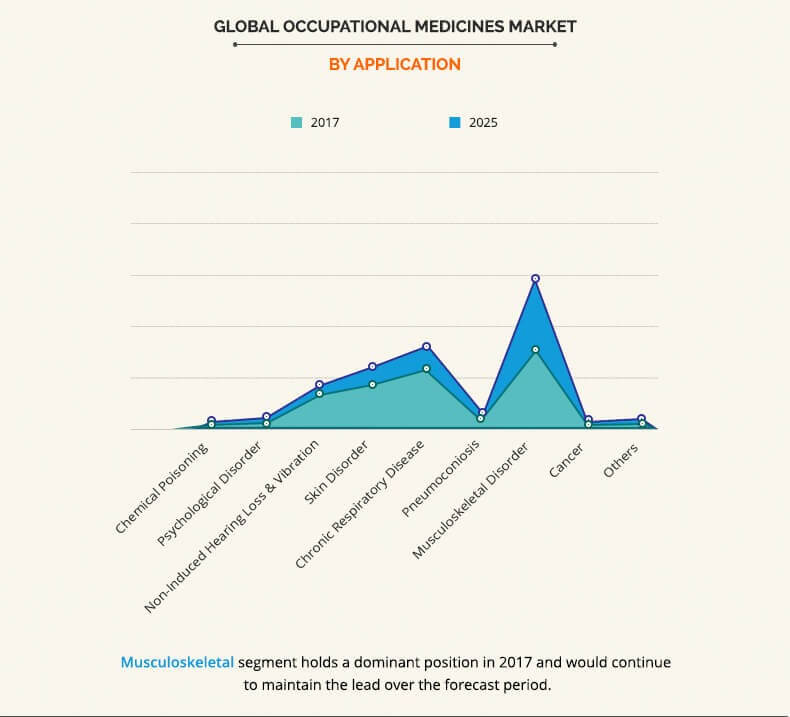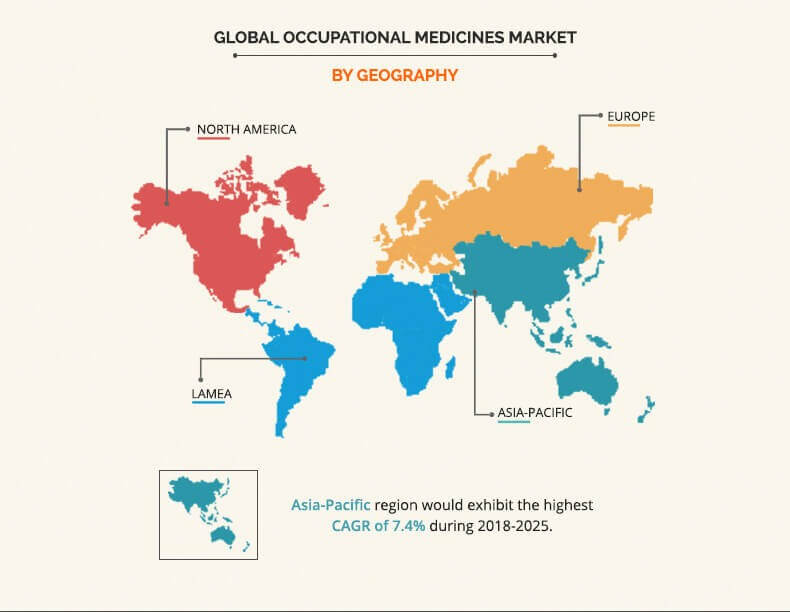Occupational Medicines Market Overview:
The global occupational medicines market was valued at $3,753 million in 2017, and is estimated to reach $5,794 million by 2025, registering a CAGR of 5.5% from 2018 to 2025. Occupational medicine is a branch of clinical medicine that specializes in treatment of diseases and injuries of people, owing to their work environment. Certain work environment conditions, such as exposure to carcinogenic chemicals and asbestos, cause diseases, such as asthma and cancer. Occupational medicines are prescribed to prevent or treat such diseases and conditions.
The global occupational medicines market is driven by the surge in awareness about occupational health. Moreover, favorable regulatory environment and rapid increase in aging workforce are the key factors that augment the growth of the market. However, emergence of small businesses, change in industry structure, and rise in incorporation of artificial intelligence (AI) and automation in the industry are some of the factors that restrain the market growth. On the contrary, the presence of untapped markets in the developing nations is expected to provide new opportunities for the key players.
The occupational medicines market is segmented based on application, industry, and region. On the basis of application, the market is divided into chemical poisoning, psychological disorder, non-induced hearing loss & vibration, skin disorder, chronic respiratory disease, pneumoconiosis, musculoskeletal disorder, cancer, and other applications. Depending on industry, it is categorized into agriculture & forestry, construction, manufacturing, petroleum & mining, transportation, and others. Region wise, it is analyzed across the North America, Europe, Asia-Pacific, and LAMEA.
The musculoskeletal disorder segment dominated the global occupational medicines market in 2017, owing to increase in elderly population, surge in prevalence of musculoskeletal disorders and rise in awareness about occupational health throughout the world.
Rise in focus of vendors on the emerging markets, such as Asia-Pacific and LAMEA, is expected to boost the occupational medicines industry growth. The Asia-Pacific region is projected to witness significant growth in future, owing to increase in R&D investment, rise in disposable income of population in this region, and surge in disease diagnosis awareness. Furthermore, this region offers remarkable opportunities for the venture capitalists and investors for business expansion, because the developed markets are comparatively saturated.
The report provides an extensive competitive analysis and profiles of the key market players, such as Amgen, Inc., AstraZeneca PLC, Bristol-Myers Squibb Company, Eli Lilly and Company, F. Hoffmann-La Roche Ltd, Johnson & Johnson, Nestl S.A. (Galderma S.A.), Novartis AG, Pfizer, Inc., and Sanofi. The other players in the value chain (not included in the report) include Merck & Co., Inc., AbbVie, Inc., and GlaxoSmithKline plc.
Key Benefits
- This report entails a detailed quantitative analysis of the current market trends from 2017 to 2025 to identify the prevailing opportunities along with strategic assessment of the global occupational medicines market.
- Occupational medicines market size and estimations are based on comprehensive analysis of the applications and developments in the industry.
- A qualitative analysis based on innovative products and devices facilitate the strategic business planning of the occupational medicines market.
- The development strategies adopted by the key market players are enlisted to understand the competitive scenario of the global occupational medicine industry.
Occupational Medicines Market Report Highlights
| Aspects | Details |
| By Application |
|
| By Industry |
|
| By Region |
|
| Key Market Players | Sanofi, Bristol-Myers Squibb Company, AstraZeneca PLC, Nestlé S.A. (Galderma S.A.), Amgen Inc., Pfizer Inc., Novartis AG, F. Hoffmann-La Roche Ltd., Eli Lilly and Company, Johnson & Johnson |
Analyst Review
Occupational medicines are extensively employed for the treatment of various diseases, such as cancer, skin conditions, respiratory disorders, and others, which are acquired owing to the work conditions of an individual. The growth of the global occupational medicine market is propelled by upsurge in geriatric population and rise in awareness associated with occupational health. Furthermore, a favorable regulatory scenario with respect to occupational medicines is anticipated to boost the market growth during the forecast period.
The use of occupational medicines is highest in Europe, attributed to the fact that the regulatory framework for occupational health and occupational medicines in Europe focuses greatly on monitoring safety and health in the work environment. The framework’s aim is to reduce occupational hazards and improve working conditions across the region. Europe is followed by North America and Asia-Pacific. In addition, drug manufacturing companies have focused on expanding their presence in the emerging economies, which is anticipated to drive the market growth.
Loading Table Of Content...





